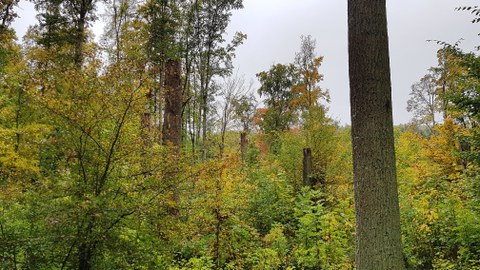01.02.2024
Neue statistische Methode, um die Beziehung von Biodiversität innerhalb und zwischen Ökosystemen zur Multifunktionalität ganzer Landschaften auszuwerten
Ökosysteme erfüllen eine Reihe lebenswichtiger Aufgaben: Sie speichern Kohlenstoff, reinigen verschmutztes Wasser, bestäuben Pflanzen und so weiter. Wie gut ein Ökosystem diese Aufgaben erfüllen kann, hängt maßgeblich ab von seiner Biodiversität, also der Vielfalt der Pflanzen, Tiere und Mikroorganismen, die in ihm leben. Wie genau es sich mit diesem Zusammenhang verhält, das konnte die Wissenschaft bislang nur auf lokaler Ebene nachvollziehen, zum Beispiel bezogen auf einzelne Waldflächen, Wiesen und Teiche. In Kooperation mit der renommierten Statistikerin und Mathematikerin Anne Chao und ihrem Team von der National Tsing Hua University in Taiwan ist der DFG-Forschungsgruppe BETA-FOR nun die Entwicklung einer statistischen Methode gelungen, die erstmals auch die Beiträge der Biodiversität zwischen lokalen Ökosystemen zur Multifunktionalität ganzer Landschaften analysieren kann.
Die neue Statistikmethode setzt die unterschiedliche Biodiversität zwischen einzelnen Ökosystemen einer Landschaft in Zusammenhang zur gesamten Multifunktionalität. Der Begriff „Multifunktionalität“ bezeichnet dabei das Bündel aller Funktionen, die ein Ökosystem gleichzeitig übernimmt. Dazu zerlegt es die Multifunktionalität einer Landschaft in zwei Komponenten – in die Funktionen auf lokaler Ebene und die zwischen verschiedenen Ökosystemen einer Landschaft. So lässt sich die Multifunktionalität in Bezug setzen zur lokalen Biodiversität und zur Biodiversität, die durch die Verschiedenartigkeit der Lebensräume entsteht. Das neue Werkzeug ist als R Paket MF.beta4 verfügbar.
Quelle: teilweise Pressemitteilung der MLU Halle-Wittenberg,
https://www.uni-wuerzburg.de/aktuelles/pressemitteilungen/single/news/neue-einblicke-in-oekosystem-funktionen/
Publikation:
Chao, A.; Chiu, C.H.; Hu, K.-H.; van der Plas, F.; Cadotte, M.; Mitesser, O.; Thorn, S.; Mori, A.; Scherer-Lorenzen, M.; Eisenhauer, N.; Bässler, C.; Delory, B.; Feldhaar, H.; Fichtner, A.; Hothorn, T.; Peters, M.; Pierick, K.; von Oheimb, G.; Müller, J. (2024): Hill-Chao numbers allow decomposing gamma-multifunctionality into alpha and beta components. Ecology Letters. DOI: 10.1111/ele.14336

